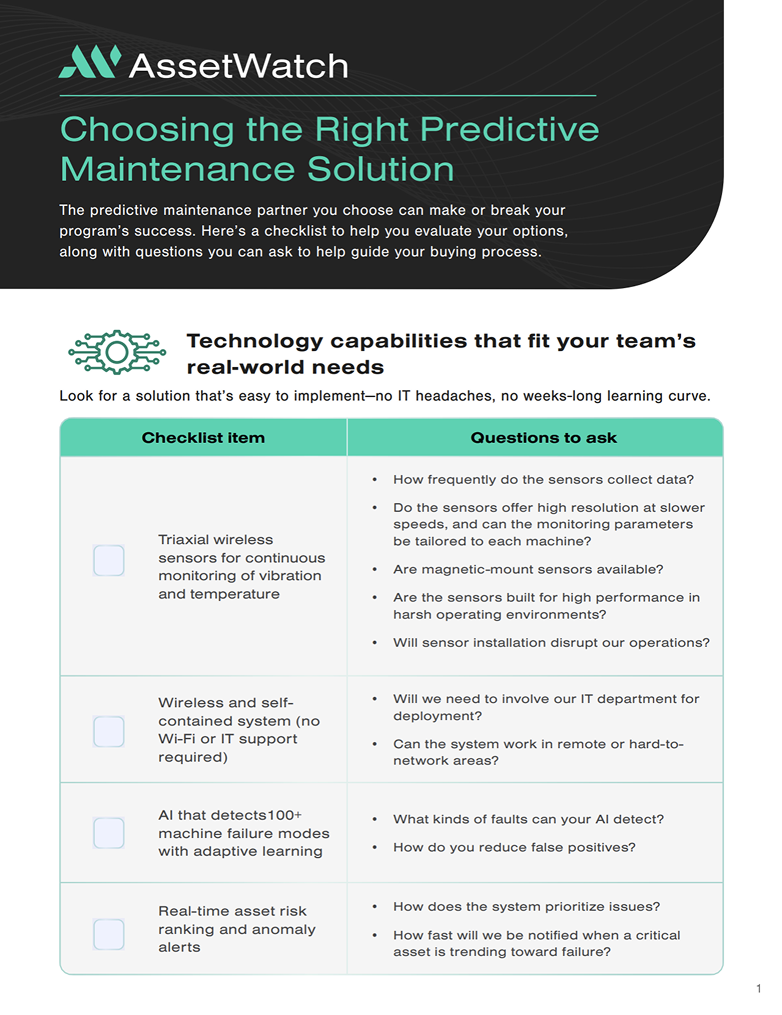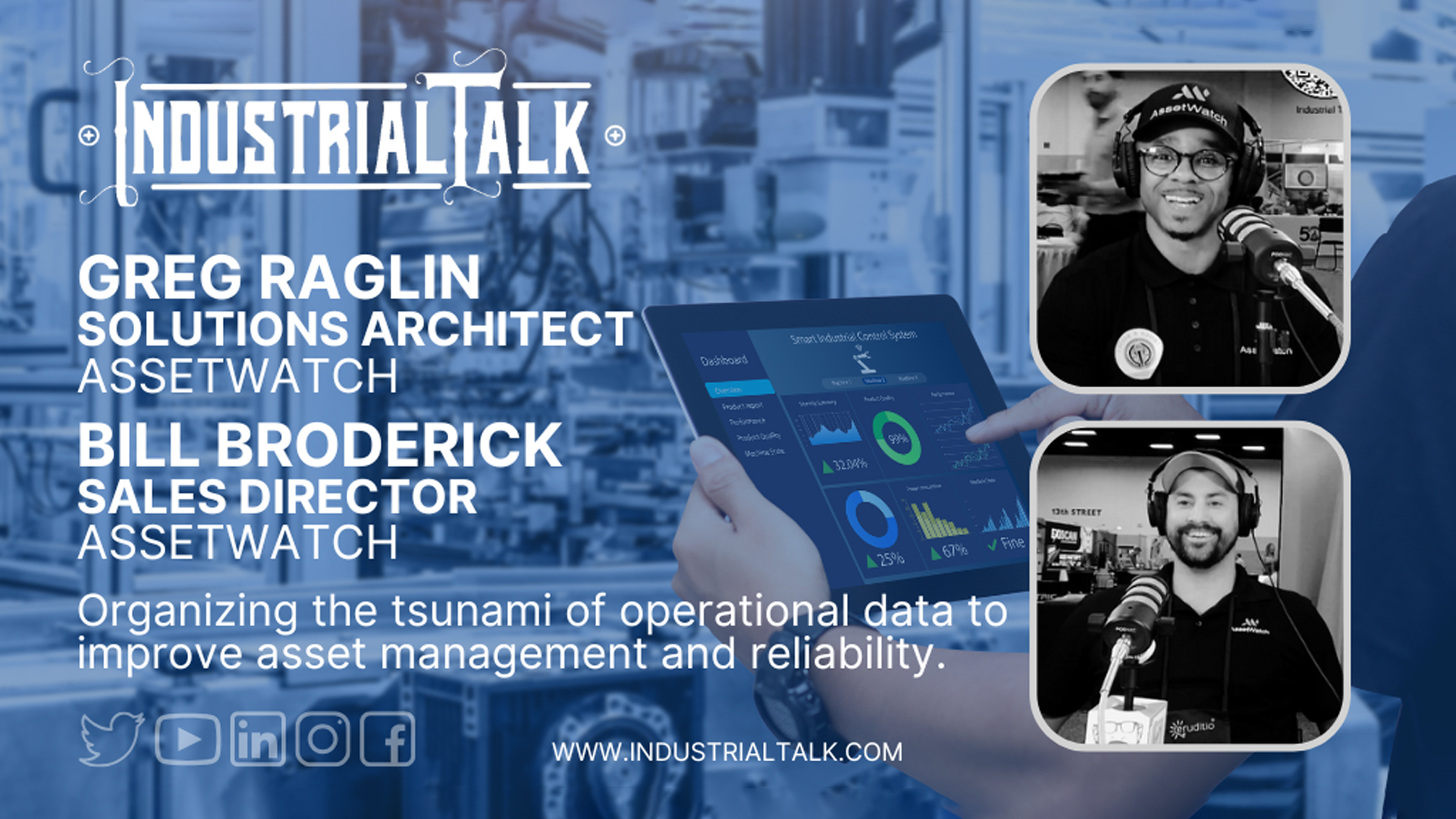When will the run-to-failure maintenance model run its course?
For plants that continue to operate in reactive maintenance mode, the costs for both industrial maintenance teams and companies at large are staggering. Stalled output, frantic callbacks, unexpected repairs, rampant workplace stress, and high employee turnover can take a major toll.
Fortunately, there's a better way: condition monitoring. More and more plants are using condition monitoring for ongoing data collection and analysis to monitor and optimize machine health. By helping ensure mission-critical equipment runs continuously as expected, condition monitoring is a game changer for both maintenance personnel and the bottom line.
If you're considering making the switch to predictive maintenance, condition monitoring is a core component. It puts the power to detect equipment problems, avoid costly failures, and prevent unplanned downtime directly in your hands.
How Does Condition Monitoring Work?
Condition monitoring involves ongoing machine health monitoring, data analysis, and issue detection and alerts. Data is collected from a targeted machine during operation, and changes in that machine data suggest a component failure. When an abnormality is detected, the problem is flagged so you can schedule and perform maintenance as needed and before failure.
In modern plants adopting Industry 4.0 technologies, the Industrial Internet of Things (IIoT) plays a vital role in condition monitoring by connecting sensors and machinery to a centralized platform. This networked infrastructure enables real-time data collection and analysis at scale, offering plant teams unprecedented visibility into equipment performance and health.
Tying it all together is a software platform that offers team members holistic, real-time visibility of the entire plant, multiple plants, and across the enterprise. Maintenance issues are ranked in order of urgency to aid decision making and efficiency.
Ideally, these capabilities are paired with prescriptive recommendations from a seasoned expert to keep equipment operating at its peak.
Introducing condition monitoring to your plant shouldn't require much effort. And it can bring big benefits to your plant, starting on day one. According to Deloitte's 2024 manufacturing industry outlook, adopting the technologies needed for effective condition monitoring can significantly improve efficiency, productivity, risk management, employee retention, profit margins, and sustainability.
4 Benefits of Condition Monitoring That Will Transform Your Plant
Before diving into condition monitoring benefits, consider the spiraling costs of the reactive maintenance model. It's not only costly in the short term, but also increasingly expensive over time, creating a domino effect that leads to equipment failures across the production line, further damage, and diminished production capacity.
Condition monitoring allows maintenance engineers to identify and resolve equipment issues before they become problems, thus preventing that domino effect. But the full range of benefits extends well beyond that.
1. Eliminate Unplanned Downtime
Unplanned downtime can destroy production output and leave employees standing idle amid rising labor costs, with negative effects trickling down to delivery schedules and client agreements—not to mention shrinking profit margins. A recent report shows that unplanned downtime costs the 500 largest companies in the world about $1.4 trillion per year, or 11% of total revenues. By eliminating unplanned downtime, condition monitoring can turn manufacturing plants from cost centers into profit centers.
2. Make Timely, Data-Driven Decisions
When you lack a maintenance plan and your machinery malfunctions, your sole concern is getting production back online as quickly as possible. This can lead you to make reactive decisions in haste. Although you may have solved the problem for the interim, it may not be the best solution in the long run.
With condition monitoring data informing your decisions, you can consider multiple factors at once. For example, let's say a component on a piece of equipment continually shows a high probability of failure. With time on your side, you can choose whether to repair or replace that component by looking at factors such as:
- The impact of repair on the machine's productivity and quality
- The time required for the replacement part to arrive and be installed
- Cost comparisons between repair and replacement
Understanding where and when to allocate resources is key to reducing maintenance costs. It also allows you to transform the maintenance process, bringing calm and predictability the plant floor.
3. Prioritize Tasks to Streamline Maintenance Processes
When you have frequent and reliable machinery updates—and no chaotic disruptions, thanks to condition monitoring—you can prioritize and schedule maintenance tasks in a way that makes sense for your production needs. You can tackle those machines that need the most attention, plan around current projects, and even make the most of planned maintenance downtime by servicing multiple machines at once.
4. Develop Accurate KPIs
Condition monitoring grants you access to a catalog of machinery data that is constantly updating. This steady stream of real-time information can be used to help you formulate KPIs that are truly reflective of your production capacity and enable more appropriate and reliable reporting. You can also use this data to calculate with greater accuracy and precision when extending supplier contracts or purchasing new equipment.
Types of Condition Monitoring Commonly in Use
These three condition monitoring techniques can be used separately, but they're often used in conjunction to ensure plant engineers have every angle covered and maximum lead time to respond.
Continuous Vibration Analysis
Vibration analysis is a means of detecting anomalies in equipment vibration patterns. Wireless sensors are attached to machines (generally Tier 1 and some Tier 2) to collect vibration data, which streams in real time to an AI-powered platform. Predictive analytics identify concerning issues, and a dedicated human in the loop (vibration analyst) verifies the data and provides insights to the team. Vibration monitoring and temperature monitoring are often performed simultaneously.
Oil Analysis
Oil collection and analysis involves taking oil samples and performing a full panel of tests to assess and help improve plant lubrication practices. The most thorough oil analysis will also provide plant maintenance personnel with dynamic asset life predictions and ROI calculations. Ideally, a dedicated lubrication analyst will perform in-depth root-cause analyses and provide prescriptive maintenance recommendations.
Route-Based Monitoring
Route-based monitoring is a process of walking a predetermined physical route, collecting condition data, and spot-checking asset health with a handheld device. This approach is useful for monitoring less critical assets (Tier 2 and Tier 3) in a flexible and efficient way. With both route-based and continuous monitoring data streaming into a single cloud-based platform, maintenance decisions can be made based on a holistic view of asset health.
Wireless Condition Monitoring Sensors: How to Get Started
If you're ready to make the move to predictive maintenance, introducing wireless condition monitoring sensors to the most critical assets in your plant for real-time monitoring is a great first step. But you want to make sure the system you choose makes the transition easy. In fact, it should be virtually effortless for your entire team.
Evaluate Condition Monitoring Solutions
If your goal is to establish a robust predictive maintenance program that optimizes plant operations, you'll need an end-to-end condition monitoring system that includes the following:
- Criticality assessment to determine where sensors are most needed
- Physical equipment installed and maintained entirely by your provider (both wireless sensors and independent cellular network for seamless connectivity)
- Predictive analytics to identify patterns in the data for early detection of anomalies
- Prescriptive recommendations from a CAT III+ certified condition monitoring engineer (CME)—a dedicated expert assigned to your plant to help your team prioritize maintenance needs and resolve issues
Ideally, your condition monitoring software should be able to track and analyze vibration, oil, and route-based data, updated in real time and fully integrated with CMMS. You should also be provided with early alerts, easy tracking, and complete visibility across the team via easy-to-use dashboards.
How you use the system and interact with your CME should be entirely up to you. You should be able to choose your responses to both critical and non-critical operational concerns. In other words, you should have control over your plant, not the other way around.
Introduce the Equipment to Your Plant
Wireless condition monitoring sensors are installed on or near bearings, where friction can create significant wear and tear. Wireless sensors can also monitor additional faults like imbalances, gear tooth breakage, and belt wear.
The sensors can be mounted three different ways, depending on the equipment being monitored and its location. Industrial-strength magnetic mounts are most common, while threaded stud mounts and/or epoxy mounts are used in washdown areas and on stainless steel surfaces. Sensors can communicate with the hub typically at distance from 50 to 80 feet, depending on the plant environment.
Transition to Condition-Based Maintenance
Using Bluetooth low energy, wireless sensors collect and securely transmit vibration and temperature data to a cloud-based online condition monitoring platform via transponder multiple times daily for analysis.
Aided by machine learning, your dedicated CME will analyze and review your data, identifying and alerting you to patterns that indicate potential pending failures. Then your CMEs will provide prescriptive maintenance recommendations and communicate with you until issues are resolved. Between proactive CME guidance and weekly equipment health reports, you'll be fully covered—with little to no effort on your part.
Condition Monitoring Is Life Changing, Starting on Day One
Using condition monitoring is the best way to maximize equipment health and performance, streamline maintenance processes, and ensure a calm, stress-free plant environment. Maintenance managers and reliability engineers can improve their predictive maintenance strategies and maximize equipment reliability and performance, while plant managers can enhance profitability through increased uptime and a happier, more productive workforce.
The cost savings that come with eliminating unplanned downtime and repairs are huge, and well worth the shift to preventive maintenance. But what you'll find most valuable is the transformation that will take place within your maintenance team as they move from a reactive to proactive maintenance culture.
Contributed by: Michael Bernhard
Michael is a Senior Solutions Architect at AssetWatch. As a previous MMA fighter and personal trainer, he knows how to bring the hard work and dedication to our manufacturing partners to help them reduce maintenance costs and improve asset reliability. Connect with him on LinkedIn.



.avif)














